Picking the Right Reciprocating Saw Blade – EASY TIPS
Leave a CommentSaw Blade Material: The first thing to check for is the material of the blade- which is also a trade-off is price and resistibility.
Ideally; you should look for bi-metal reciprocating saw blades as they combine durable metals. This makes it last a good length of time. Plus it makes chopping operations seamless and perfect.
Try and avoid saw blades made with carbon steel or those made from HSS (High-Speed steel)
Material and Pattern of Its Tooth: You will find in some saw blades, the material used to prepare its teeth are different from the one used for the blade. There’s an explanation for this. The tooth material mainly determines the material it is meant to cut. However; you also get metal teeth designed with the very material used for the blade.
Example: Carbide teeth saw blades for cutting wood, plastic and carbide grit teeth saw blades for cutting cast iron, fibreglass, clay, metal, ceramic, etc.
As for its tooth pattern- it is the pattern attached to the reciprocating saw blade, and mainly determines the speed and quality of the cutting operation.
The common two tooth patterns accessible in the market are Wavy Set and Raker Set.
- Raker set: Great for rapid cuts and leaves behind a rough finish.
- Wavy set: Apt for slower cuts and known for its excellent finish.
Do figure out the kind of work you will be doing and accordingly choose.

The Blade Thickness and Length: This is also one of the key drawcards of selecting a quality reciprocating saw blade. You should opt for blades with an adequate amount of thickness as they usually tend to be adequate for critical operations. Furthermore, also determine the material type on which you will be using the blade.
As for its proper length- again you need to determine the thickness of the material you want to cut.
Example- If you want to use it for plumbing, then short blades work great. Contrarily; you ought to choose long blades to perform pruning or for removing large tree branches.
Also Its Gullet and TPI: ‘Gullet denotes the space between the blade’s teeth.’ Be it Gold reciprocating saw blades or Diamond reciprocating saw blades, the size of the bullet plays a very crucial role in determining the appropriateness of the saw blade.
Example: For crosscutting operations, saws with small gullet blades are more appropriate. Whereas, for hard-core ripping operations; you ought to pick a saw with deep gullet for removing large chips!
TPI- is Teeth per Inch, and usually is the standard measure for a reciprocating saw’s cutting speed. The more TPI in the blade, the smoother and cleaner are the cuts.
For cutting metals, opt for saw blades with 14-18 TPI, and 3-4 TPI for normal cutting or backyard maintenances.

The Brand and Price: Last, but certainly not the least; you must always pick saw blades from notable brands (and its accessories) in the market. Their warranty, credibility and operational quality present peace-of-mind.
For its price (which is the oldest facto to keep in mind) check industry-standard rates to get a clear idea. Don’t pay more than needed. In fact, always strike a balance between quality and cost.
If you have any further questions concerning saw blades, feel free to contact here.
Wedge Anchors: It’s Holding Values & Numerous Uses
Leave a CommentIn generic terms, a wedge anchor is a kind of fastener used to hold a wide range of materials to concrete. It goes in the industry by many other names like:
• Kwik Bolts
• Thunder stud
• Powder stud
But regardless of what name it is called or of what brand it belongs, every single type of this anchor follows the same working principle. Plus, they are more likely to be made with the same basic making materials, which make them similarly in performance too.
Digging Deeper:
A wedge anchor has two detached pieces which are pre-assembled into one single unit, permanently!
I. The first crucial piece is the carbon steel rod which is threaded for a specific part of its length! The end of the anchor that’s installed consists of conical shape or a necked-down diameter tapering outwards and back to its rod’s total diameter.
II. The next important piece of a wedge anchor is its steel slip or sleeve which is assembled at a conical part of its rod.
The interesting thing here is that each wedge anchor needs a washer and nut for its proper installation. And they play a crucial role in numerous applications, provided the base material is durable concrete! They come in a wide range of lengths and diameters, and can be used for performing both lightweight and heavy-weight operations, with ease!
Example: A wedge anchor with A 1/4″ x 1-3/4″ is apt for light-duty applications. And a 1-1/4″ x 12″ anchor deems appropriate for heavy-duty operations.
However, these wedges are suitable for application when dealing with block or brick.

Holding Power:
The holding capacity of a wedge anchor depends on the concrete quality, and as per the rule-of-thumb, it should have a working load of 4.1 (25%) to be regarded as safe!
It holding capacity can also be determined by the embedment depth. Normally, the deeper the embedment, the more its holding capacity!
One key aspect here is ensuring that no two wedge anchors are too closely set together. And the reason being, the pressure exerted can intersect and reduce both the anchor’s holding capacity. The same rules apply when they are placed near any unsupported edge/corner.
Another possibility of placing two anchors too closely to some unsupported corner/edge is the concrete crumbling under the weight of the pressure.
Golden Rules to Adhere:
• When using an anchor with a 1/2″ diameter, it should be at a distance of 2-1/2″ from the unsupported concrete edge.
• Also, two anchors must not be at a distance of 10 diameters from one another. This means two anchors with 1/2” diameter must be kept at 5” distance (at least).
Its Wide Utilities
A wedge anchor serves a lot of utility in vivid constructing applications and heavy-metal use environment- both inside and outside.
It is even great for underwater usage like for swimming pools. However, if this is the purpose of use, then using 304 and 306 stainless steel type of anchors work best!
For plating and extremely dry conditions, zinc plating deems appropriate, while for relatively humid weather conditions hot-dipped galvanised wedge anchor is a wise choice.
For you, the right thing would be to visit quality and reputed wedge anchors supplier in Belcroft Avenue and sort out your appropriate options. Carefully browse through their wedge anchor options and then pick as per the needs!

